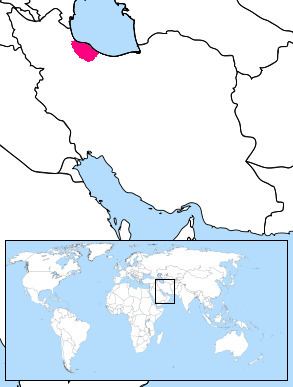ISO 639-3 glk | ||
 | ||
Native speakers 4 million (2006)3.3 million (1993) Language family Indo-EuropeanIndo-IranianIranianWestern IranianCaspianGilaki Dialects Western GilakiEastern GilakiGaleshi | ||
The Gilaki language is a Caspian language, and a member of the northwestern Iranian language branch, spoken in Iran's Gīlān Province. Gilaki is closely related to Mazandarani and the two languages have similar vocabularies. The Gilaki and Mazandarani languages (but not other Iranian languages) share certain typological features with Caucasian languages (specifically South Caucasian languages), reflecting the history, ethnic identity, and close relatedness to the Caucasus region and Caucasian peoples of the Gilaki people and Mazandarani people.
Contents
Classification
The language is divided into three dialects: Western Gilaki, Eastern Gilaki, and Galeshi (in the mountains of Gilan). Furthermore, the Gilaki language is closely related to Mazanderani, and the two languages have similar vocabularies.The western and eastern dialects are separated by the Sefid River. According to Ethnologue, there were more than 3 million native speakers of Gilaki in 1993. By 2006 there were 4 million native speakers of Gilaki.
There are three main dialects but larger cities in Gilan have slight variations to the way they speak. These "sub-dialects" are Rashti, Rudbari, Some’e Sarai, Lahijani, Langerudi, Rudsari, Bandar Anzali and Fumani.
A slightly differente style of Gilaki (eastern dialect) is spoken in the city of Ramsar, Mazandaran. The dialect has been influenced by the Mazandarani language and is sometimes referred to as Mazandarani-Gilaki although most refer to it as Ramsari.
Grammar
Gilaki, similar to Mazandarani, is an inflected and genderless language. It is considered SVO, but in some tenses it may be SOV, depending on dialects however.
Phonology
Gilaki has the same consonants as Persian, but different vowels. Here is a table of correspondences for the Western Gilaki of Rasht, which will be the variety used in the remainder of the article:
The consonants are:
Typology
The Gilaki and Mazandarani languages (but not other Iranian languages) share certain typological features with Caucasian languages (specifically South Caucasian languages), reflecting the history, ethnic identity, and close relatedness to the Caucasus region and Peoples of the Caucasus of the Gilaki people.
Verb system
The verb system of Gilaki is very similar to that of Persian. All infinitives end in -tən/-dən, or in -V:n, where V: is a long vowel (from contraction of an original *-Vdən). The present stem is usually related to the infinitive, and the past stem is just the infinitive without -ən or -n (in the case of vowel stems).
Present tenses
From the infinitive dín, "to see", we get present stem din-.
Present indicative
The present indicative is formed by adding the personal endings to this stem:
Present subjunctive
The present subjunctive is formed with the prefix bí-, bú-, or bə- (depending on the vowel in the stem) added to the indicative forms. Final /e/ neutralizes to /ə/ in the 3rd singular and the plural invariably lacks final /i/.
The negative of both the indicative and the subjunctive is formed in the same way, with n- instead of the b- of the subjunctive.
Preterite
From xurdən, "to eat", we get the perfect stem xurd. To this are added unaccented personal endings and the unaccented b- prefix (or accented n- for the negative):
Imperfect
The imperfect is formed with what was originally a suffix -i:
Pluperfect
The pluperfect is paraphrastically formed with the verb bon, "to be", and the past participle, which is in turn formed with the perfect stem+ə (which can assimilate to become i or u). The accent can fall on the last syllable of the participle or on the stem itself:
Past subjunctive
A curious innovation of Western Gilaki is the past subjunctive, which is formed with the (artificial) imperfect of bon+past participle:
This form is often found in the protasis and apodosis of unreal conditions, e.g., mən agə Əkbəra bidé bim, xušhal bubosti bim, "If I were to see/saw/had seen Akbar, I would be happy".
Progressive
There are two very common paraphrastic constructions for the present and past progressives. From the infinitive šon, "to go", we get:
Compound verbs
There are many compound verbs in Gilaki, whose forms differ slightly from simple verbs. Most notably, bV- is never prefixed onto the stem, and the negative prefix nV- can act like an infix -n-, coming between the prefix and the stem. So from fagiftən, "to get", we get present indicative fagirəm, but present subjunctive fágirəm, and the negative of both, faángirəm or fanígirəm. The same applies to the negative of the past tenses: fángiftəm or fanígiftəm.
Nouns, cases and postpositions
Gilaki employs a combination of quasi-case endings and postpositions to do the work of many particles and prepositions in English and Persian.
Cases
There are essentially three "cases" in Gilaki, the nominative (or, better, unmarked, as it can serve other grammatical functions), the genitive, and the (definite) accusative. The accusative form is often used to express the simple indirect object in addition to the direct object. A noun in the genitive comes before the word it modifies. These "cases" are in origin actually just particles, similar to Persian ra.
Nouns
For the word "per", father, we have:
The genitive can change to -i, especially before some postpositions.
Pronouns
The 1st and 2nd person pronouns have special forms:
The 3rd person (demonstrative) pronouns are regular: /un/, /u.ˈʃan/, /i.ˈʃan/
Postpositions
With the genitive can be combined many postpositions. Examples:
The personal pronouns have special forms with "-re": mere, tere, etc.
Adjectives
Gilaki adjectives come before the noun they modify, and may have the genitive "case ending" -ə/-i. They do not agree with the nouns they modify.
